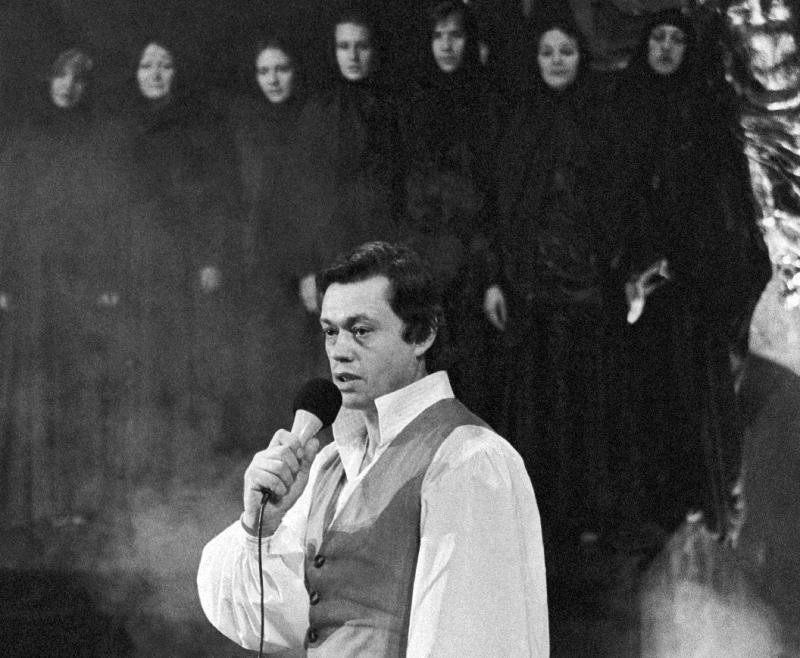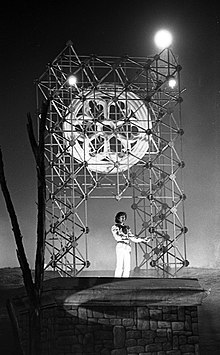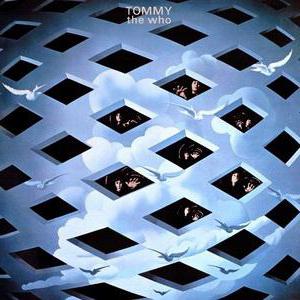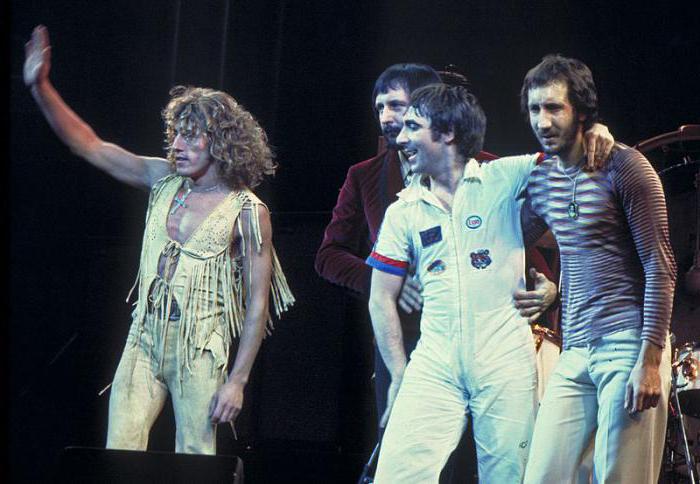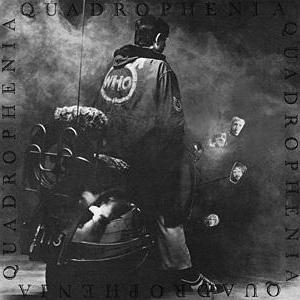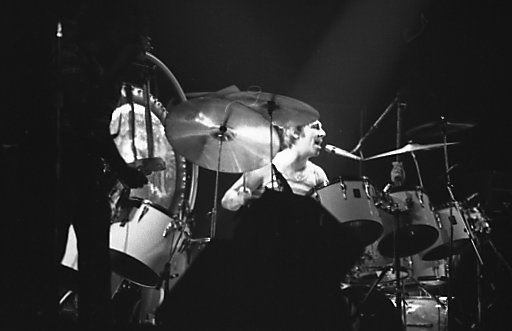Жанр рок-оперы возник в 1960-х годах. Основоположником стал Пит Таунсенд, который вместе со своей группой The Who выпустил альбом «Tommy». Хотя некоторые критики считают, что первой была команда The Pretty Things со своей концептуальной пластинкой «S.F. Sorrow». Наиболее известным в СССР и РФ представителем жанра стал композитор Алексей Рыбников. Предлагаем вашему вниманию подборку самых известных рок-опер.
«Tommy»
Культовый альбом The Who о жизненном пути слепоглухонемого мальчика по имени Томми долгое время не сходил с театральных подмостков. Первая адаптация концептуальной пластинки появилась в виде хореографической постановки. А к оперной версии привлекли актрису Бетт Мидлер. В течение 1972 и 1973 годов «Tommy» аккомпанировал Лондонский симфонический оркестр. В 1975 году пластинка была успешно экранизирована режиссёром Кеном Расселлом. В 2003 году альбом попал на 96 место в списке величайших альбомов всех времён по версии журнала Rolling Stone, а песни «Pinball Wizard», «I’m Free», «We’re Not Gonna Take It» и «See Me, Feel Me» были признаны чуть ли не вершинами творчества Пита Таунсенда и его легендарной команды.
«Юнона» и «Авось»
В 1978 году композитор Алексей Рыбников показал режиссёру Марку Захарову свои импровизации на темы православных песнопений. Тогда же возникла идея о создании музыкального спектакля на сюжет «Слова о полку Игореве». Захаров обратился с предложением написать либретто к поэту Андрею Вознесенскому, однако тот идею не поддержал. Но предложил взамен свою поэму «Авось», посвящённую путешествию русского государственного деятеля Николая Резанова в Калифорнию, где он встретился с юной Кончитой Аргуэльо. Словосочетание «рок-опера» в те времена было запрещено, поэтому публике представили ее как «современную оперу». Главные роли исполнили Николай Караченцов, Елена Шанина, Александр Абдулов и Павел Смеян. Параллельно со спектаклем в 1980 году записали и ее аудиоверсию, но уже с другими исполнителями. Премьера состоялась 9 июля 1981 года. Спектакль выдержал более тысячи представлений и до сих пор идёт с неизменным аншлагом. Опера была переведена на многие языки и поставлена во многих странах.
«Иисус Христос – суперзвезда»
В своей третьей совместной работе Эндрю Ллойд Уэббер и Тим Райс решили рассказать историю Иисуса Христа через рок-песни. Роль главного героя была отдана Иуде, который изображается рациональной личностью, в отличие от слишком эмоционального и не вполне понимающего цель собственной жертвы Иисуса. Партию Спасителя исполнил вокалист группы Deep Purple Иэн Гиллан. Изначально эта роль была предложена Джону Леннону, однако тот выставил условие, чтобы роль Марии Магдалины исполнила его жена Йоко Оно — предложение отозвали. В 1971 году альбом с рок-оперой возглавил чарты Billboard, а на Бродвее состоялась премьера одноименного мюзикла. В 1973 году произведение экранизировали, что очень не понравилось религиозным организациям. В 2000 году рок-опера была переснята австралийскими кинематографистами с новым режиссёрским решением и вышла на DVD под названием «Jesus Christ Superstar. Millennium Version». Российский ремейк классического творения записан в 1992 году со звездным составом. Место нашлось и рокерам: например, Сергей Минаев исполнил роль Иуды. Христоса доверили петь Михаилу Серышеву из группы Мастер, которая тогда как раз записывала свои самые «сатанинские» альбомы. На записи можно услышать голоса Евгений Маргулиса (Ирод) и даже Валерия Кипелова (Симон Зелот). На сцене звездный состав так и не выступил.
«Звезда и смерть Хоакина Мурьеты»
Еще одно совместное творение «Ленкома» и Алексея Рыбникова. Это одна из самых успешных отечественных рок-опер: спектакль шел на протяжении 17 сезонов. А ведь могло получиться совсем иначе: предпремьерные показы вызвали шквал негативной критики среди чиновников из Управления культуры, в результате чего спектакль 11 раз запрещали к показу Основа либретто – кантата чилийского классика Пабло Неруды «Сияние и смерть Хоакина Мурьеты» о разбойнике, подло убитом в Калифорнии. Роль Мурьеты исполнил Александр Абдулов, роль Смерти — Николай Караченцов. Спектакль пытались экранизировать, а в 2008 Рыбников поставил «обновленную» версию с Дмитрием Колдуном и Светланой Светиковой в главных ролях.
«Мастер и Маргарита»
Творение Александра Градского 2009 года примечательно тем, что его мало кто слышал. Работа над оперой велась с 1985 года. Был собран звездный состав: Андрей Макаревич, Иосиф Кобзон, Игорь Бутман, Олег Табаков, Максим Леонидов, Валерий Золотухин и даже Дживан Гаспарян. Но Градский решил отказаться не только от самой идеи постановки, но даже от массового распространения диска. Сначала проблемы возникли из-за авторских прав на роман. Когда вопрос решили, Александр издал рок-оперу подарочным, тиражом. Те, кому посчастливилось услышать «Мастера и Маргариту», отмечают, что слушать ее без либретто непросто: Александр Градский спел сразу за Мастера, Иешуа, Воланда и Кота Бегемота. И порой не очень понятно, кто из героев поет в данный момент.
«Эльфийская рукопись»
Метал-опера и концептуальный альбом пауэр-метал-группы «Эпидемия» увидел свет 13 февраля 2004 года. Сценарий оперы — это фэнтези-история, написанная гитаристом Юрием Мелисовым. Сначала постановка должна была основываться на книжной серии Dragonlance, но в итоге получился самостоятельный сюжет. Продюсировал все гитарист Арии Владимир Холстинин. Роли исполняли сами участники группы Эпидемия, Артур Беркут, Дмитрий Борисенков из Черного Обелиска, Кирилл Немоляев из Бони НЕМ, Александра Чеботарёва и Алексей «Lexx» Кравченко из Мастера. Показы каждый раз проходят с аншлагом. По просьбам поклонников группа играла оперу и на выступлениях в турах по России, правда получалось не в таком масштабе, как в столице.
«TODD»
Рок-мюзикл «TODD» (она же зонг-опера ужасов) переживает уже 7 театральный сезон. В 2010 году Михаил Горшенёв увлёкся театрально-постановочной деятельностью. В процессе работы родилась идея создания театрально-музыкального проекта про маньяка-парикмахера Суини Тодда. Так появился на свет мюзикл «TODD», в который постепенно влились все музыканты группы Король и Шут. Театральная премьера состоялась в ноябре 2012 года в московском Театре киноактёра. Ее предварил выход музыкального альбома «TODD» в двух частях со всеми песнями проекта, объединенными в настоящий аудиоспектакль. В записи приняли участие Константин Кинчев, Юлия Коган, Билли Новик, Илья Черт, а повествовательный текст прочитал актер театра и кино Вениамин Смехов. После смерти в июле 2013 года исполнителя главной роли и идейного вдохновителя Михаила Горшенева на главную роль был приглашён Роберт Остролуцкий.
Рок-о́пера (англ. rock opera) — это опера в жанре рок-музыки.
Рок-оперы представляют собой музыкально-сценические произведения, где в ариях, исполняемых множеством вокалистов по ролям, раскрывается сюжет оперы. При этом по музыке арии написаны в стиле рок, на сцене могут вместе с солистами присутствовать гитаристы и прочие рок-музыканты.
Рок-оперы могут быть как единоразовой записью, так и постоянно действующим представлением с постоянным или меняющимся составом исполнителей. Часто для записи или живого исполнения рок-опер на главные роли приглашают солистов из известных групп. Наличие ролей и сюжета отличает рок-оперы от простого концептуального альбома.
История
Жанр рок-оперы возник в 1960-х годах. Основоположником жанра и изобретателем самого термина «rock opera» считается Пит Таунсенд, лидер рок-группы The Who. Именно этот коллектив в 1969 году выпустил альбом «Томми» (Tommy), на обложке которого впервые значилось название нового жанра. Однако исторически первооткрывателями жанра может считаться британская группа The Pretty Things с концептуальным альбомом «S.F. Sorrow», записанным в 1967 и вышедшем в 1968 году, но не имевшем, в отличие от «Томми», оглушительного коммерческого успеха.
Рок-оперы в России
Русскоязычные рок-оперы представлены рядом произведений советского периода:
- «Орфей и Эвридика», «Юнона и Авось» Рыбникова,
- «Звезда и смерть Хоакина Мурьеты», «Стадион», «Алые паруса» (А. Богословский, записана ВИА «Музыка» в 1977 году),
а также современными произведениями:
- «2032: Легенда о несбывшемся грядущем», «Эльфийская рукопись», «Преступление и наказание» Артемьева,
- «Жанна д’Арк», «Паганини», «Кентервильское привидение», «Царь-Девица», «Последнее испытание», «Мастер и Маргарита» Градского, «Ангел Мести» — Сергея Ефимова и Достоваловой Дарьи, молодых музыкантов из Иркутской области.
Немного об Авторах
Алексей Рыбников позиционирует свои произведения как «современную оперу», Виктор Аргонов определил жанр своей оперы «2032: Легенда о несбывшемся грядущем» как оперу в стиле техно. Вместе с тем, общей особенностью большинства перечисленных произведений является крупная форма, наличие как вокальных, так и речевых и инструментальных участков, философская и историческая направленность, связь с русскими классическими традициями (в особенности у Рыбникова и Артемьева.
В последнее время на территории России стали популярными фолк-рок-оперы, такие как «Тампль», «Жанна д’Арк» и другие, а также рок-опера по мотивам произведений фэнтези «Дорога без возврата».
Существенное отличие произведений советского периода заключается в широкой известности, которую они получили, тогда как современные произведения жанра являются сугубо адресными продуктами, не способными получить коммерческую известность. Печальным примером здесь может служить опера Эдуарда Артемьева «Преступление и наказание», которая писалась автором почти 30 лет, но выход которой в 2007 году практически не был замечен широким слушателем, несмотря на мировую известность автора.
Постановки в этом жанре, как правило, реализуются антрепризно или в театрах других направлений — драматических, в лучшем случае музыкальных. Единственный театр в нашей стране, специализирующийся на рок-операх, это Санкт-Петербургский театр «Рок-опера».
Известные рок-оперы
- Иисус Христос — суперзвезда (1970) — Эндрю Ллойд Уэббер, Тим Райс
- Томми (англ. Tommy, 1969) группа The Who
- Квадрофения (англ. Quadrophenia, 1973) — группа The Who
- Звезда и смерть Хоакина Мурьеты (1975) — Алексей Рыбников
- Стена (англ. The Wall, 1979) — группа Pink Floyd
- Юнона и Авось (1980) — Алексей Рыбников
- Zen Arcade (1984) — Hüsker Dü
- Стадион (1985) — Александр Градский
- Streets: A Rock Opera (1991) — группа Savatage
- Metropolis Pt. 2: Scenes from a Memory (1999) — Dream Theater
- Avantasia (2001) — Тобиас Саммет (Edguy)
- American Idiot (2004) — Green Day
- Эльфийская рукопись (2004) — группа Эпидемия
- Эльфийская Рукопись: Сказание на все времена (2007) — группа Эпидемия
- Выбор судьбы (2006)
- Преступление и наказание (2007) — Эдуард Артемьев
- Рипо! Генетическая опера (2008)
- She (2008) — проект Caamora Клайва Нолан
- Equilibrio (2008) — Xystus
- Последнее Испытание (2009)
- Мастер и Маргарита (2009) — Александр Градский
- Дорога без возврата (2009) — группа ESSE
- Моцарт. Рок-опера (2009) (Dove Attia et Albert Cohen)
- 21st Century Breakdown (2009) — Green Day
- Человек-паук: Погасить тьму (2011) — Стэн Ли
- Ангел Мести (2010) — группа Голос Неба
См. также
- Концептуальный альбом
- Мюзикл
Ссылки
- Историческая Метал-Опера «Bona Sforza d’Aragona»
- Официальная страница музыканта Сергея Ефимова
- Рок-опера Ангел Мести на Jamendo
| |
||
|---|---|---|
| Театр |
Драматический театр • Театр музыкальной комедии • Водевиль |
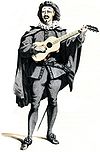 |
| Музыкальный театр |
Оперный театр • Театр оперетты • Театры балета • Мюзикл • Мюзик-холл • Рок-опера |
|
| Жанры |
Драма • Комедия • Трагедия • Трагикомедия • Мелодрама |
|
| Театральные школы |
Система Станиславского • Система Михаила Чехова • Биомеханика Мейерхольда • Монодрама Н. Н. Евреинова • Система Ежи Гротовского • Система Антонина Арто • Авторский театр • Театр абсурда • Театр повествования |
|
| Направления в театре |
Комедия дель арте • Театр пантомимы • Театр пародии • Театр одного актёра • Уличный театр |
|
| Разновидности театра |
Театр юного зрителя • Кукольный театр • Театр теней • Театр зверей • Театры огня |
|
| Камерный театр |
Камерный театр • Камерный балет • Театр миниатюр • Интимный театр • Камерная музыка • Камерный оркестр |
|
| Разное |
театральные училища • театральная терминология • театральные амплуа • театральные критики |
A rock opera is a collection of rock music songs with lyrics that relate to a common story. Rock operas are typically released as concept albums and are not scripted for acting, which distinguishes them from operas, although several have been adapted as rock musicals. The use of various character roles within the song lyrics is a common storytelling device. The success of the rock opera genre has inspired similar works in other musical styles, such as rap opera.
History[edit]
A number of rock artists became interested in the idea of creating a rock opera in the 1960s. In an early use of the term, the July 4, 1966, edition of RPM Magazine (published in Toronto) reported that «Bruce Cockburn and Mr [William] Hawkins are working on a Rock Opera, operating on the premise that to write you need only ‘something to say’.»[1] Mark Wirtz explored the idea in a project A Teenage Opera, from which an early song «Excerpt from A Teenage Opera (Grocer Jack)» recorded by Keith West was released and became a hit song in 1967.[2][3] However, the album for the rock opera was not released until 1996, and it was only fully realised and staged in 2017.[4]
Colin Fleming of The Atlantic described The Story of Simon Simopath (1967) by British psychedelic band Nirvana as an «early foray into the rock opera sub-genre».[5] Neil Strauss of The New York Times wrote that S.F. Sorrow (1968) by The Pretty Things is «generally acknowledged as the first rock opera».[6]
Scott Mervis of the Pittsburgh Post-Gazette wrote that The Who’s 1969 record Tommy was the first album to be billed as a rock opera.[7] The album tells the story of Tommy Walker, a «deaf, dumb and blind kid.» Tommy displays the titular character’s experiences with life and his relationship with his family. Although the band’s guitarist Pete Townshend denied taking any influence from S.F. Sorrow, critics have compared Tommy to it. The Tommy album developed into other media, including a Seattle Opera production in 1971, an orchestral version by Lou Reizner in 1972, a film in 1975, and a Broadway musical in 1992. The original album has sold 20 million copies and has been inducted into the Grammy Hall of Fame. Tommy would also go on to influence On and On, a rap opera by The Fat Boys[8] and American Idiot, a punk rock opera by Green Day.[9] The Who had previously toyed with the concepts which would lead to the full-blown rock opera with their six-movement 1966 track «A Quick One, While He’s Away».[10]
A rock opera that experienced commercial recording and Broadway success is Jesus Christ Superstar (1970), written by Andrew Lloyd Webber and Tim Rice, and in respect of which Lloyd Webber said «the piece was written as a rock album from the outset and set out from the start to tell the story through the music itself.»[11]
The Rocky Horror Show is a rock musical by Richard O’Brien. A humorous tribute to the science fiction and horror B movies of the 1930s through to the early 1960s, the musical tells the story of a newly engaged couple getting caught in a storm and coming to the home of a mad transvestite scientist, Dr Frank-N-Furter, unveiling his new creation, a sort of Frankenstein-style monster in the form of an artificially made, fully grown, physically perfect muscle man named Rocky. The show was produced and directed by Jim Sharman. The original London production of the musical premiered at the Royal Court Theatre (Upstairs) on 19 June 1973 (after two previews on 16 and 18 June 1973). It later moved to several other locations in London and closed on 13 September 1980. The show ran for a total of 2,960 performances and won the 1973 Evening Standard Theatre Award for Best Musical. Various international productions of the musical have since spanned across six continents as well as West End and Broadway revivals and eight UK tours. Actor Tim Curry, who originated the role of Dr. Frank-N-Furter in the original London production, became particularly associated with the musical. The musical was adapted into the 1975 film The Rocky Horror Picture Show, starring O’Brien as Riff Raff, with Curry also reprising his role; the movie has the longest-running release in cinematic history and is considered one of the most recognizable cult films of all time. In 2016, it was adapted into the television film The Rocky Horror Picture Show: Let’s Do the Time Warp Again.
A Night at the Opera is a studio album by the British rock band Queen, released on 21 November 1975. Produced by Roy Thomas Baker and Queen, it was reportedly the most expensive album ever recorded at the time of its release.[12] Queen employed a complex production that extensively used multitrack recording, and the songs on the album incorporated a wide range of styles, such as ballads, music hall, dixieland, hard rock and progressive rock influences. Aside from their usual equipment, Queen also utilized a diverse range of instruments such as a double bass, harp, ukulele and more, correlating the album’s music with that of a typical operatic performance. The album’s most famous track, «Bohemian Rhapsody,» was referred to by lead singer Freddie Mercury as a «mock opera» that resulted from the combination of three songs he had written. The song parodies elements of opera with bombastic choruses, sarcastic recitative, and distorted Italian operatic phrases. Lyrical references include Scaramouche, the fandango, Galileo Galilei, Figaro, and Beelzebub, with cries of «Bismillah!»
Bat Out of Hell is an epic rock album by Meat Loaf that remains one of the best-selling albums of all time, having sold over 50 million copies worldwide.[13] It is certified 14× Platinum by the Recording Industry Association of America (RIAA).[14] As of June 2019, it has spent 522 weeks in the UK Albums Chart, the second longest chart run by a studio album.[15] Rolling Stone ranked it at number 343 on its list of the 500 Greatest Albums of All Time.[16][17] A musical based on Bat Out of Hell, staged by Jay Scheib, opened at the Manchester Opera House in 2017. The album’s producer, Jim Steinman, coined the term Wagnerian rock after composer Richard Wagner to describe the genre of the record.
Perhaps the archetypal and most famous rock opera is The Wall, a double album released by Pink Floyd in 1979. The Wall chronicles the story of Pink, a character who ultimately constructs an emotional wall to protect himself after being driven into insanity as a result of traumatic life experiences. The album was included in Rolling Stone‘s lists of the greatest albums of all time in 2003, 2012, and 2020.[18] James Guthrie, the album’s engineer, won the 1980 Grammy award for Best Engineered Recording (non-classical), and the album was nominated for the Grammy Award for Album of the Year.[19] The album was subsequently made into a 1982 film entitled Pink Floyd – The Wall. An elaborate 1980-1981 concert tour was conducted by the band after the album’s release and bassist Roger Waters reincarnated the tour twice; once in Berlin in 1990 to commemorate the fall of the Berlin Wall and again around the world from 2010-2013, a series of shows that became the highest-grossing tour by a solo musician. Both The Wall and the music of Queen inspired the rock band My Chemical Romance to create their own rock opera, the 2006 album The Black Parade.
In 1999 progressive metal band Dream Theater released their album Metropolis Pt. 2: Scenes from a Memory, which has been regarded as Rock Opera.[20] The album tells the story of Nicholas, a man getting flashbacks from a previous life, as he undergoes hypnosis sessions to recall the memories of Victoria, a young girl who he discovers was murdered as a violent result of a love affair.
In an effort to appeal to more modern audiences, opera companies have welcomed more pop and rock influences. The resulting rock operas have met varying degrees of success as the worlds of high art and low art mix.[21] In Russian music, the term zong-opera (Зонг-опера) is sometimes used, since the first Soviet-Russian rock-opera Orpheus and Eurydice was described with this term, though the term «rock-opera» was already known in the Soviet rock music circles.
Style[edit]
According to Fleming, rock operas are more akin to a cantata or suite, because they are not usually acted out.[5] Similarly, Andrew Clements of The Guardian called Tommy a subversively-labeled musical. Clements states that lyrics drive rock operas, which makes them not a true form of opera.[22] Responding to accusations that rock operas are pretentious and overblown, Pete Townshend wrote that pop music by its very nature rejects such characteristics and is an inherently simple form. Townshend said that the only goal of pop music is to reach audiences, and rock operas are merely one more way to do so.[23] Peter Kiesewalter, on the other hand, said that rock music and opera are «both overblown, massive spectacles» that cover the same themes. Kiesewalter, who was originally not a fan of opera, did not think the two styles would mix well together, but his modernized operas with rock music surprised him with their popularity at the East Village Opera Company.[24]
The performance of these works on Broadway has also courted controversy; Anne Midgette of The New York Times called them musicals with «no more than the addition of a keyboard and a drum set».[25]
Rock opera albums typically follow themes, a trait similarly held in a concept album. Rock operas may also include a central character to progress the album’s tracks via a specific storyline. For example, Tommy by The Who follows the life experiences and family relationships with the titular character, The Wall by Pink Floyd chronicles the building of a metaphorical wall by the protagonist named Pink and The Black Parade by My Chemical Romance tells the tale of «The Patient» struck by cancer.
See also[edit]
- Album era
- Concept album
- List of rock musicals
- The Survival of St. Joan
- Trans-Siberian Orchestra
- True Symphonic Rockestra
- Wagnerian rock
References[edit]
- ^ Maconie, Stuart (2013). The People’s Songs: The Story of Modern Britain in 50 Records. p. 167. ISBN 9781409033189.
- ^ Webb, Robert (July 10, 2021). «Excerpt from a Teenage Opera by Keith West». The Independent.
- ^ Atkins, John (2015). The Who on Record. MacFarland. p. 111. ISBN 9781476606576 – via Google Books.
- ^ Thorpe, Vanessa (July 30, 2017). «Grocer Jack has his day as A Teenage Opera finally goes on stage». The Guardian.
- ^ a b Fleming, Colin (November 15, 2011). «The Who Made the Best Rock Opera Ever, but It’s Not the One You Think». The Atlantic. Archived from the original on May 24, 2014. Retrieved May 24, 2014.
- ^ Strauss, Neil (September 3, 1998). «THE POP LIFE; The First Rock Opera (No, Not ‘Tommy’)». The New York Times. Retrieved May 24, 2014.
- ^ Mervis, Scott (November 6, 2012). «The Who resurrects its ‘other’ rock opera, ‘Quadrophenia’«. Pittsburgh Post-Gazette. Archived from the original on May 25, 2014. Retrieved May 24, 2014.
- ^ Wayne, Renee Lucas (October 5, 1989). «Fat Boys Built To Rap Opera Album Hits Stores Today». Philadelphia Daily News. Archived from the original on March 29, 2016. Retrieved May 24, 2014.
- ^ Ruggieri, Melissa (April 29, 2014). «‘American Idiot’ brings heart of rock ‘n’ roll to stage». The Atlanta Journal-Constitution. Archived from the original on May 18, 2014. Retrieved May 24, 2014.
- ^ Unterberger, Richie. «A Quick One, While He’s Away — The Who». Allmusic. Retrieved December 10, 2022.
- ^ «Jesus Christ Superstar, a Rock Opera — Classic Rock Review». www.classicrockreview.com. Archived from the original on November 24, 2017.
- ^ Jones, Chris. «BBC — Music — Review of Queen — A Night at the Opera». www.bbc.co.uk. Retrieved November 10, 2019.
- ^ Whitaker, Sterling (October 21, 2012). «35 Years Ago: Meat Loaf’s ‘Bat Out of Hell’ Released». Ultimate Classic Rock. Retrieved December 28, 2014.
- ^ «RIAA Database, Bat Out of Hell». Recording Industry Association of America. Retrieved February 11, 2011.
- ^ «Meat Loaf: In and Out of Hell». BBC. July 15, 2015.
- ^ «500 Greatest Albums of All Time». Rolling Stone. May 31, 2012. Retrieved September 9, 2018.
- ^ «500 Greatest Albums of All Time Rolling Stone’s definitive list of the 500 greatest albums of all time». Rolling Stone. 2012. Retrieved September 9, 2019.
- ^ «The 500 Greatest Albums of All Time». Rolling Stone. September 22, 2020. Archived from the original on December 10, 2020. Retrieved September 24, 2020.
- ^ Grammy Award Winners (search for The Wall), National Academy of Recording Arts and Sciences, archived from the original on October 2, 2009, retrieved October 7, 2009
- ^ Littleton, Candice (October 25, 2016). «Dream Theater Metropolis, Pt. 2 A Legendary Prog Rock Opera». ClassicRockHistory.com. Retrieved January 11, 2023.
- ^ Swed, Mark (August 17, 2007). «At last, a rock opera that sings». Boston.com. Archived from the original on May 25, 2014. Retrieved May 24, 2014.
- ^ Clements, Andrew (February 8, 2002). «When is an opera not an opera?». The Guardian. Archived from the original on May 25, 2014. Retrieved May 24, 2014.
- ^ Townshend, Pete (March 30, 2002). «Tommy, get your gun…» The Guardian. Archived from the original on May 25, 2014. Retrieved May 24, 2014.
- ^ Brookes, Stephen (March 28, 2008). «Rock Opera. Seriously». The Washington Post. Archived from the original on June 6, 2014. Retrieved May 24, 2014.
- ^ Midgette, Anne (January 28, 2006). «Cruising and Schmoozing While Looking for Mr. Right». The New York Times. Retrieved May 24, 2014.
External links[edit]
- «Rock Opera». Fonts. Daylight. Retrieved April 14, 2020.
A rock opera is a collection of rock music songs with lyrics that relate to a common story. Rock operas are typically released as concept albums and are not scripted for acting, which distinguishes them from operas, although several have been adapted as rock musicals. The use of various character roles within the song lyrics is a common storytelling device. The success of the rock opera genre has inspired similar works in other musical styles, such as rap opera.
History[edit]
A number of rock artists became interested in the idea of creating a rock opera in the 1960s. In an early use of the term, the July 4, 1966, edition of RPM Magazine (published in Toronto) reported that «Bruce Cockburn and Mr [William] Hawkins are working on a Rock Opera, operating on the premise that to write you need only ‘something to say’.»[1] Mark Wirtz explored the idea in a project A Teenage Opera, from which an early song «Excerpt from A Teenage Opera (Grocer Jack)» recorded by Keith West was released and became a hit song in 1967.[2][3] However, the album for the rock opera was not released until 1996, and it was only fully realised and staged in 2017.[4]
Colin Fleming of The Atlantic described The Story of Simon Simopath (1967) by British psychedelic band Nirvana as an «early foray into the rock opera sub-genre».[5] Neil Strauss of The New York Times wrote that S.F. Sorrow (1968) by The Pretty Things is «generally acknowledged as the first rock opera».[6]
Scott Mervis of the Pittsburgh Post-Gazette wrote that The Who’s 1969 record Tommy was the first album to be billed as a rock opera.[7] The album tells the story of Tommy Walker, a «deaf, dumb and blind kid.» Tommy displays the titular character’s experiences with life and his relationship with his family. Although the band’s guitarist Pete Townshend denied taking any influence from S.F. Sorrow, critics have compared Tommy to it. The Tommy album developed into other media, including a Seattle Opera production in 1971, an orchestral version by Lou Reizner in 1972, a film in 1975, and a Broadway musical in 1992. The original album has sold 20 million copies and has been inducted into the Grammy Hall of Fame. Tommy would also go on to influence On and On, a rap opera by The Fat Boys[8] and American Idiot, a punk rock opera by Green Day.[9] The Who had previously toyed with the concepts which would lead to the full-blown rock opera with their six-movement 1966 track «A Quick One, While He’s Away».[10]
A rock opera that experienced commercial recording and Broadway success is Jesus Christ Superstar (1970), written by Andrew Lloyd Webber and Tim Rice, and in respect of which Lloyd Webber said «the piece was written as a rock album from the outset and set out from the start to tell the story through the music itself.»[11]
The Rocky Horror Show is a rock musical by Richard O’Brien. A humorous tribute to the science fiction and horror B movies of the 1930s through to the early 1960s, the musical tells the story of a newly engaged couple getting caught in a storm and coming to the home of a mad transvestite scientist, Dr Frank-N-Furter, unveiling his new creation, a sort of Frankenstein-style monster in the form of an artificially made, fully grown, physically perfect muscle man named Rocky. The show was produced and directed by Jim Sharman. The original London production of the musical premiered at the Royal Court Theatre (Upstairs) on 19 June 1973 (after two previews on 16 and 18 June 1973). It later moved to several other locations in London and closed on 13 September 1980. The show ran for a total of 2,960 performances and won the 1973 Evening Standard Theatre Award for Best Musical. Various international productions of the musical have since spanned across six continents as well as West End and Broadway revivals and eight UK tours. Actor Tim Curry, who originated the role of Dr. Frank-N-Furter in the original London production, became particularly associated with the musical. The musical was adapted into the 1975 film The Rocky Horror Picture Show, starring O’Brien as Riff Raff, with Curry also reprising his role; the movie has the longest-running release in cinematic history and is considered one of the most recognizable cult films of all time. In 2016, it was adapted into the television film The Rocky Horror Picture Show: Let’s Do the Time Warp Again.
A Night at the Opera is a studio album by the British rock band Queen, released on 21 November 1975. Produced by Roy Thomas Baker and Queen, it was reportedly the most expensive album ever recorded at the time of its release.[12] Queen employed a complex production that extensively used multitrack recording, and the songs on the album incorporated a wide range of styles, such as ballads, music hall, dixieland, hard rock and progressive rock influences. Aside from their usual equipment, Queen also utilized a diverse range of instruments such as a double bass, harp, ukulele and more, correlating the album’s music with that of a typical operatic performance. The album’s most famous track, «Bohemian Rhapsody,» was referred to by lead singer Freddie Mercury as a «mock opera» that resulted from the combination of three songs he had written. The song parodies elements of opera with bombastic choruses, sarcastic recitative, and distorted Italian operatic phrases. Lyrical references include Scaramouche, the fandango, Galileo Galilei, Figaro, and Beelzebub, with cries of «Bismillah!»
Bat Out of Hell is an epic rock album by Meat Loaf that remains one of the best-selling albums of all time, having sold over 50 million copies worldwide.[13] It is certified 14× Platinum by the Recording Industry Association of America (RIAA).[14] As of June 2019, it has spent 522 weeks in the UK Albums Chart, the second longest chart run by a studio album.[15] Rolling Stone ranked it at number 343 on its list of the 500 Greatest Albums of All Time.[16][17] A musical based on Bat Out of Hell, staged by Jay Scheib, opened at the Manchester Opera House in 2017. The album’s producer, Jim Steinman, coined the term Wagnerian rock after composer Richard Wagner to describe the genre of the record.
Perhaps the archetypal and most famous rock opera is The Wall, a double album released by Pink Floyd in 1979. The Wall chronicles the story of Pink, a character who ultimately constructs an emotional wall to protect himself after being driven into insanity as a result of traumatic life experiences. The album was included in Rolling Stone‘s lists of the greatest albums of all time in 2003, 2012, and 2020.[18] James Guthrie, the album’s engineer, won the 1980 Grammy award for Best Engineered Recording (non-classical), and the album was nominated for the Grammy Award for Album of the Year.[19] The album was subsequently made into a 1982 film entitled Pink Floyd – The Wall. An elaborate 1980-1981 concert tour was conducted by the band after the album’s release and bassist Roger Waters reincarnated the tour twice; once in Berlin in 1990 to commemorate the fall of the Berlin Wall and again around the world from 2010-2013, a series of shows that became the highest-grossing tour by a solo musician. Both The Wall and the music of Queen inspired the rock band My Chemical Romance to create their own rock opera, the 2006 album The Black Parade.
In 1999 progressive metal band Dream Theater released their album Metropolis Pt. 2: Scenes from a Memory, which has been regarded as Rock Opera.[20] The album tells the story of Nicholas, a man getting flashbacks from a previous life, as he undergoes hypnosis sessions to recall the memories of Victoria, a young girl who he discovers was murdered as a violent result of a love affair.
In an effort to appeal to more modern audiences, opera companies have welcomed more pop and rock influences. The resulting rock operas have met varying degrees of success as the worlds of high art and low art mix.[21] In Russian music, the term zong-opera (Зонг-опера) is sometimes used, since the first Soviet-Russian rock-opera Orpheus and Eurydice was described with this term, though the term «rock-opera» was already known in the Soviet rock music circles.
Style[edit]
According to Fleming, rock operas are more akin to a cantata or suite, because they are not usually acted out.[5] Similarly, Andrew Clements of The Guardian called Tommy a subversively-labeled musical. Clements states that lyrics drive rock operas, which makes them not a true form of opera.[22] Responding to accusations that rock operas are pretentious and overblown, Pete Townshend wrote that pop music by its very nature rejects such characteristics and is an inherently simple form. Townshend said that the only goal of pop music is to reach audiences, and rock operas are merely one more way to do so.[23] Peter Kiesewalter, on the other hand, said that rock music and opera are «both overblown, massive spectacles» that cover the same themes. Kiesewalter, who was originally not a fan of opera, did not think the two styles would mix well together, but his modernized operas with rock music surprised him with their popularity at the East Village Opera Company.[24]
The performance of these works on Broadway has also courted controversy; Anne Midgette of The New York Times called them musicals with «no more than the addition of a keyboard and a drum set».[25]
Rock opera albums typically follow themes, a trait similarly held in a concept album. Rock operas may also include a central character to progress the album’s tracks via a specific storyline. For example, Tommy by The Who follows the life experiences and family relationships with the titular character, The Wall by Pink Floyd chronicles the building of a metaphorical wall by the protagonist named Pink and The Black Parade by My Chemical Romance tells the tale of «The Patient» struck by cancer.
See also[edit]
- Album era
- Concept album
- List of rock musicals
- The Survival of St. Joan
- Trans-Siberian Orchestra
- True Symphonic Rockestra
- Wagnerian rock
References[edit]
- ^ Maconie, Stuart (2013). The People’s Songs: The Story of Modern Britain in 50 Records. p. 167. ISBN 9781409033189.
- ^ Webb, Robert (July 10, 2021). «Excerpt from a Teenage Opera by Keith West». The Independent.
- ^ Atkins, John (2015). The Who on Record. MacFarland. p. 111. ISBN 9781476606576 – via Google Books.
- ^ Thorpe, Vanessa (July 30, 2017). «Grocer Jack has his day as A Teenage Opera finally goes on stage». The Guardian.
- ^ a b Fleming, Colin (November 15, 2011). «The Who Made the Best Rock Opera Ever, but It’s Not the One You Think». The Atlantic. Archived from the original on May 24, 2014. Retrieved May 24, 2014.
- ^ Strauss, Neil (September 3, 1998). «THE POP LIFE; The First Rock Opera (No, Not ‘Tommy’)». The New York Times. Retrieved May 24, 2014.
- ^ Mervis, Scott (November 6, 2012). «The Who resurrects its ‘other’ rock opera, ‘Quadrophenia’«. Pittsburgh Post-Gazette. Archived from the original on May 25, 2014. Retrieved May 24, 2014.
- ^ Wayne, Renee Lucas (October 5, 1989). «Fat Boys Built To Rap Opera Album Hits Stores Today». Philadelphia Daily News. Archived from the original on March 29, 2016. Retrieved May 24, 2014.
- ^ Ruggieri, Melissa (April 29, 2014). «‘American Idiot’ brings heart of rock ‘n’ roll to stage». The Atlanta Journal-Constitution. Archived from the original on May 18, 2014. Retrieved May 24, 2014.
- ^ Unterberger, Richie. «A Quick One, While He’s Away — The Who». Allmusic. Retrieved December 10, 2022.
- ^ «Jesus Christ Superstar, a Rock Opera — Classic Rock Review». www.classicrockreview.com. Archived from the original on November 24, 2017.
- ^ Jones, Chris. «BBC — Music — Review of Queen — A Night at the Opera». www.bbc.co.uk. Retrieved November 10, 2019.
- ^ Whitaker, Sterling (October 21, 2012). «35 Years Ago: Meat Loaf’s ‘Bat Out of Hell’ Released». Ultimate Classic Rock. Retrieved December 28, 2014.
- ^ «RIAA Database, Bat Out of Hell». Recording Industry Association of America. Retrieved February 11, 2011.
- ^ «Meat Loaf: In and Out of Hell». BBC. July 15, 2015.
- ^ «500 Greatest Albums of All Time». Rolling Stone. May 31, 2012. Retrieved September 9, 2018.
- ^ «500 Greatest Albums of All Time Rolling Stone’s definitive list of the 500 greatest albums of all time». Rolling Stone. 2012. Retrieved September 9, 2019.
- ^ «The 500 Greatest Albums of All Time». Rolling Stone. September 22, 2020. Archived from the original on December 10, 2020. Retrieved September 24, 2020.
- ^ Grammy Award Winners (search for The Wall), National Academy of Recording Arts and Sciences, archived from the original on October 2, 2009, retrieved October 7, 2009
- ^ Littleton, Candice (October 25, 2016). «Dream Theater Metropolis, Pt. 2 A Legendary Prog Rock Opera». ClassicRockHistory.com. Retrieved January 11, 2023.
- ^ Swed, Mark (August 17, 2007). «At last, a rock opera that sings». Boston.com. Archived from the original on May 25, 2014. Retrieved May 24, 2014.
- ^ Clements, Andrew (February 8, 2002). «When is an opera not an opera?». The Guardian. Archived from the original on May 25, 2014. Retrieved May 24, 2014.
- ^ Townshend, Pete (March 30, 2002). «Tommy, get your gun…» The Guardian. Archived from the original on May 25, 2014. Retrieved May 24, 2014.
- ^ Brookes, Stephen (March 28, 2008). «Rock Opera. Seriously». The Washington Post. Archived from the original on June 6, 2014. Retrieved May 24, 2014.
- ^ Midgette, Anne (January 28, 2006). «Cruising and Schmoozing While Looking for Mr. Right». The New York Times. Retrieved May 24, 2014.
External links[edit]
- «Rock Opera». Fonts. Daylight. Retrieved April 14, 2020.
Сегодня мы расскажем о том, что такое рок-опера. Понятие имеет англоязычное происхождение и в оригинале звучит так — rock opera. Речь идет об опере, созданной в жанре рок-музыки. Далее обсудим это явление с разных сторон.
Общие сведения
Чтобы разобраться в вопросе, что такое рок-опера следует отметить, что речь идет о музыкально-сценическом произведении. Арии здесь исполняются по ролям множеством вокалистов. Таким способом сюжет оперы раскрывается.
Музыка арий пишется в рок-стиле. На сцене с солистами могут присутствовать различные музыканты, чаще всего гитаристы. Чтобы понять, что такое рок-опера, важно знать, что она может быть представлена как единоразовый проект, либо постоянно действующее представление с меняющимся, либо единым составом исполнителей.
Часто для живого исполнения или записи таких постановок для главных ролей приглашаются солисты известных групп. Наличие сюжета и ролей отличает подобное действо от концептуального альбома.
История
Разобраться в том, что такое рок-опера поможет рассмотрение этапов формирования этого жанра. Он возник в 1960 годы. Изобретателем понятия rock opera и основоположником жанра стал лидер группы The Who Пит Таунсенд. Этот коллектив выпустил в 1969 году альбом «Томми». На его обложке впервые появилось название интересующего нас жанра.
Однако исторически в качестве первооткрывателей данного явления можно назвать британскую группу The Pretty Things. Данный коллектив в 1968 г. выпустил концептуальный альбом «S.F. Sorrow». Однако данная работа, в отличие от пластинки «Томми», не имела столь оглушительного коммерческого успеха.
Особенности в СССР и на территории России
Алексей Рыбников свои произведения позиционирует как «современную оперу». Виктор Аргонов также обращался к интересующему нас явлению. Свое произведение «2032: Легенда о несбывшемся грядущем» автор определил как оперу, относящуюся к стилю техно.
Общей особенностью большей части подобных произведений является связь с традициями классики, историческая и философская направленность, наличие инструментальных, речевых и вокальных участков, крупная форма. Особенно это характерно для Артемьева и Рыбникова.
В России особую популярность обрели фолк-рок-оперы. Среди них следует отметить произведения ордена «Тампль». В основу ряда работ положены мотивы произведений в жанре фэнтези, в частности, «Дорога без возврата».
Произведения советского периода получили широкую известность. Современные работы интересующего нас жанра являются адресными и коммерческого успеха зачастую не достигают. Показательным примером может служить в данном случае опера «Преступление и наказание» Эдуарда Артемьева. Автор писал это произведение почти тридцать лет, но выход его в 2007 г. широкой общественностью практически замечен не был, не взирая на мировую известность Эдуарда Артемьева.
Постановки этого жанра, чаще всего, осуществляются в театрах других направлений. Однако в России существует одно заведение, специализирующееся на этом жанре. Речь идет о Санкт-Петербургском театре «Рок-опера». Далее подробнее поговорим о произведениях.
Наиболее известные постановки
Рок-опера «Юнона и Авось». Речь идет об одном из наиболее известных произведений такого жанра, созданных в СССР. Автор — Алексей Рыбников. Благодаря стихам поэта Андрея Вознесенского была создана данная рок-опера.
«Авось» — это поэма, которая легла в основу либретто. Однако театральная постановка потребовала дополнительного создания сцен и арий. Премьера состоялась в 1981 г. в Московском театре имени Ленинского комсомола. Спектакль входит в репертуар этого заведения по сей день.
Рок-опера «Суперзвезда» (оригинальное название Jesus Christ Superstar) – произведение Тима Райса и Эндрю Ллойда Уэббера, написанное в 1970 г. Спустя год его поставили на Бродвее. В одноименном альбоме, который был выпущен в 1970 г., заглавная партия была исполнена вокалистом Deep Purple по имени Иэн Гиллан. В записи участвовали и другие знаменитые исполнители: Ивонн Эллиман, Пол Рэйвен, Виктор Брокс, Майк Д’Або, Мюррей Хэд.
В 1973 г. Норман Джуисон — режиссёр мюзикла — его экранизировал. Фильм был снят в Израиле на местах исторических событий, которые разворачивались на заре христианства. Данная работа получила высокие оценки кинокритиков.
При этом проект подвергся нападкам различных религиозных организаций. В 2000 г. опера была снята австралийскими кинематографистами. Данный проект получил название Millennium Version, новый актёрский состав и режиссёрское решение.

